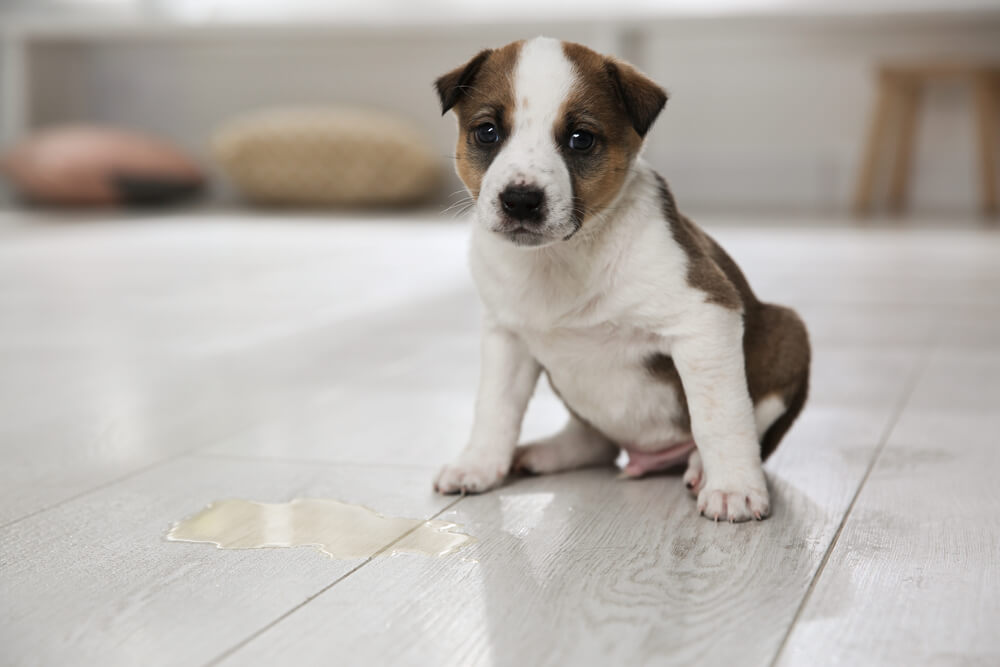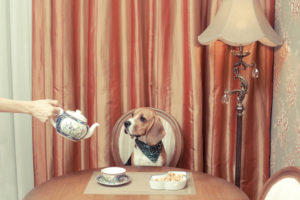Typically, it takes anywhere from 8 to 12 weeks with careful supervision to potty train a puppy.
A new puppy makes an exciting addition to any family.
Puppies are much like human babies. They’re not capable of fully controlling their bodies, including their bowels, for the first few months of life.1 Aligning your expectations with the puppy’s physical abilities will prevent frustration for both of you.
In This Article
When Should I Start House Training?
House training starts with a consistent, patient owner, realistic expectations, and a house training plan. The first step to house training begins before your puppy enters the home. Decide where you’d like your puppy to eliminate. Choosing a specific spot or area will help your puppy associate eliminating himself in the same place, which means he’s more likely not to eliminate himself in other areas. A potty training plan that includes the area of the house to the door you’d like the dog to use are important.
It’s also a good idea to have a quality cleaning product that eliminates odors. Accidents will happen. A dog’s sensitive nose will detect the smell of urine or feces, acting as a cue to go in the same spot again. Consequently, be ready to clean up accidents promptly and thoroughly.
How Old Should My Puppy Be Before I Start Potty Training?
House training can begin as soon as you bring the puppy home, around seven to eight weeks old. However, depending on how old the puppy is, it could be a while before he’s capable of controlling his bladder and bowels and consistently going at and in the appropriate places.
Like humans, puppies have to learn what it feels like when their body tells them it’s time ‘to go.’ However, you can help him by taking him to eliminate himself on a regular schedule. Puppies (and dogs) typically need to go:
- at least once during the night (until about two to five months old)
- immediately after waking in the morning or after a nap
- after a big drink or meal
- during and/or after playtime
- every one to two hours, in addition to the above times
You and your family will need to keep a close eye on your puppy and follow a regular schedule until he starts to recognize his need to eliminate on his own. That might take close observation on your part, but most puppies give some signs of needing to go.
Signs Your Puppy Needs To Eliminate
Every puppy is different, but there are some predictable behaviors that indicate your pup needs to relieve himself. Pups often stop whatever they’re doing or sniff and circle before they go in for the squat. As soon as you see your puppy starting to show these behaviors, take him on a trip outside to his potty area.
Housetraining 101
Here are 5 key consideration for housetraining your puppy:
1. Leash and Companionship
Always use a leash to take your puppy to eliminate himself. A leash assures that he doesn’t run away if he gets startled or excited. Stay with your pup. Don’t send your pup out alone because he may skip going potty to get back to his favorite people.
2. Use the Same Spot
Take him to the same area every time to help him learn where you’d like him to go. It can take a couple of eliminations for a puppy to completely empty his bladder. Be sure to wait two to five minutes for the first elimination, and stay an extra few minutes to make sure he’s finished.
3. Praise and Reward
Praise and reward your pup in a happy, calm voice and offer a small treat. Reward your pup near his ‘go’ spot rather than after he’s back inside, so he understands what he’s being praised for.
4. Intro a Cue
Some owners like to introduce a cue, like “go potty,” “bathroom,” or something similar. When your pup starts to eliminate, say the cue word quietly and calmly. This process helps them associate the word with the act.
5. Train the “Ask”
As house training progresses, you can train your dog to “ask” to go. Some dogs do this on their own by staring at or going to the door or barking at their person. You can train the dog to ring a bell near the door or some other audible signal if you’d prefer. Be sure to praise your dog when he successfully responds to the “ask.”
What To Do When You’re Gone
Potty training can get derailed when your puppy is left unsupervised. A general rule of thumb is that a puppy can hold their urine for their age plus one in hours.2 If your pup is four months old, that means he can probably hold his urine for five hours.
Crate your puppy or section off a small area of your house if you’ll be gone within the safe window of elimination. Make sure the crate or area is somewhere your puppy enjoys being. You can do that by offering toys and treats inside this area at times when you’re around, so he has positive associations with it.
If you’re gone longer than the puppy can realistically hold their urine, try confining your puppy to a specific area and include a pee pad where he can relieve himself. It might take time to train your dog to go on a pee pad too, so again, try to be patient.
Housetraining Tips and Tricks
- Feed your dog on a consistent schedule. Pups have to go 15 to 20 minutes after a meal. That gives you a good idea of when he might need to go and an excellent opportunity for a successful potty trip.
- Take your dog out every two hours in the early days of house training. Set an alarm to take him out at least once a night.
- Constant supervision is key to consistent training. Try not to leave your puppy alone for more than two to three hours at a time. If you have to be gone longer, leave your puppy in a small area with a pee pad or other place that he’s been trained to go.
- Don’t get angry at your puppy or rub his face in his waste if he has an accident. Instead, clean it thoroughly and stick to your training, including close supervision.
- If your pup starts going while you’re watching, make a loud noise to interrupt him and immediately take him to the appropriate area.
- If your puppy’s trip outside isn’t successful (as in he doesn’t go when you know he probably needs to), try confining your puppy to his crate, the kitchen or laundry room, or another confined space for 15 minutes and try again.
When Is My Puppy Fully House Trained?
Puppies aren’t considered fully house trained until they’ve gone 8 to 12 weeks without an accident. Some puppies can achieve this by six months old. However, others may take a year to reach this point. Remember that puppies are all different, just like people. Their bodies and abilities develop on their own schedule. Try to be patient and consistent as you guide your pup through proper house training.
Additional Resources
We’ve created a lot of great resources for new dog owners:
- Our New Puppy Checklist
- A Guide to crate train a puppy
- A guide to getting a puppy to sleep through the night
- Our Puppy Weight Calculator
- Our puppy growth chart
Article Sources
Pet News Daily uses only high-quality sources, including peer-reviewed studies, to support the facts within our articles. Read our editorial process to learn more about how we fact-check and keep our content accurate, reliable, and trustworthy.
- Bray, et al. Dog cognitive development: a longitudinal study across the first 2 years of life. Animal Cognition. 2021;24(2): doi: 10.1007/s10071-020-01443-7
- Herron, Meghan. Behavior guide for your new puppy. vet.osu.edu. Accessed November 26, 2021.


